Interviews
Keith Wilson Interview
Starburst 13 (September 1979), p22-27
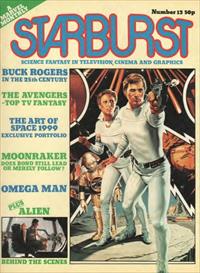
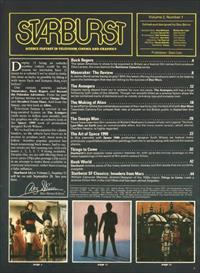
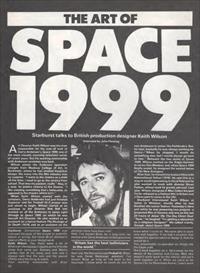
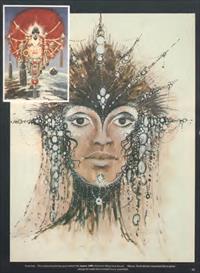
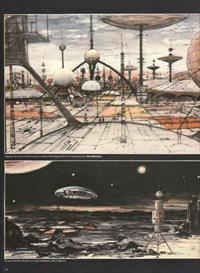



Interview by John Fleming
Art Director Keith Wilson was the man responsible for the over-all look of Gerry Anderson's Space: 1999, one of the most visually stunning television series of recent years. But his working relationship with Anderson stretches way back.
Wilson joined the Anderson operation straight from Medway College of Art., in Rochester where he had studied theatrical design. His move into the film industry was no surprise: "I went to the cinema as a child all the time, I used to go to the cinema from school That was my passion really". Also, in a way, he prefers cinema to the theatre: "I like creating something that's believable, as opposed to the theatre which isn't."
When Keith Wilson started with the company, Gerry Anderson had just finished Supercar and his Fireball XL-5 project was just about to begin. Wilson -started as an assistant to Art Director Bob Bell and worked on all the Anderson TV series right through to Space: 1999, on which he was himself Art, director He also worked as an assistant on a horror feature The Revenge of Dr Death (1974) and as an assistant on the non-Anderson TV series The Pathfinders. But, he says, basically he was always working for Gerry - "'When he stopped, I would do something else, but I would always go back to him."
Between the two series of Space: 1999, Wilson worked on the Anglo-German TV series Star Maidens and, when Space: 1999 finally ended, he designed the second series of The New Avengers.
After that, he, moved into feature films with International Velvet (1978). He saw this as a way to avoid typecasting in the SF field and he also wanted to work with director Bryan Forbes, whose work he greatly admired. Last year, Wilson designed A Man Called Intrepid (to be released as a feature film in Britain and a three-part TV series in the US).
Starburst interviewed Keith Wilson at Home in Windsor, shortly after he had finished the soccer feature Yesterday's Hero and while he was preparing two projects: a proposed film of Genesis and one on the last 24 hours of Jesus' life The Day Christ Died. "Now,"' he laughed "I'm getting a reputation as a religious designer!" We talked mainly, though, about Space: 1999.
Starburst: Sometimes Space: 1999 was criticised because of the scripts or scientific details or acting, but never Brian Johnson's special effects or your design work.
Keith Wilson: Yes, there were a lot of American (newspaper) reports at the time the show first came out. Barbara and Martin Landau had all the press sent over and it always said that the sets and the special effects were the thing to watch,
Your working relationship With Brian Johnson must have been vital.
Well, I've known Brian for a long time. He started with Gerry Anderson at the same time that I did. His first series was Fireball XL-5 too: he was Derek Meddings' assistant. I've known Brian as long as I've been in the business. I knew what he could do and he knew what I could do. We were able to work very well together. If we had a situation that needed his special talent to design it, then he would do it.
You presumably co-operated on things like the Eagle craft.
We'd work together on it. He'd show me the sketch of the exterior and I'd say, Well, this doesn't really work for the interior
and we'd work together on it. When we came to do Space City (ie Moonbase Alpha), I said I want to do this style of modular building which will alter the shape of your model
. So, from that point of view, we worked very together. But he was at Bray Studios, and I was at Pinewood so we saw very little of each other in fact.
Why did you choose a modular design for Moonbase?
Well, for actually building the sets, it was absolutely essential. I wanted this clinical science-fiction look and I had to be able to construct sets very, very quickly. We virtually had an alien planet or an alien spaceship every two weeks, so I couldn't spend a lot of time on the Moonbase sets.
I designed the modular system so that, within hours, I could build another set or another room or I could just open the whole thing up and make it into a series of corridors very quickly because everything fitted together like a big jigsaw. I spent a lot of time and a lot of the money at the beginning of the series designing that system, knowing that once it was built I could virtually forget it and I could concentrate all my efforts on the alien planets. It was the only way to do it.
Some people might think It's easy to design a room.
It's not just a matter of designing a room where you're going to shoot scenes with certain people in. The idea is to design something, which you can believe that person would live in. It doesn't matter what it is. Whether it's science fiction or it's Genesis. You've got to believe it and that's the whole point of my job.
In Science fiction, designing rooms that reflect their occupants' personalities can't be easy.
Doing Space was a problem because I had created a clinical atmosphere, therefore expressing personality was very difficult. This room that we're sitting in has little touches of me because I live here, and have lived here for a while. It has accumulated its personality from my personality. But to put a group of people on the Moon in a clinical atmosphere and give that atmosphere a personality is very, very difficult.
I believe you tried to give the uniforms more character In the second series by giving them pockets and so on.
That's right. On the first series of Space, we had a "'name"' to design the costumes - Rudi Gernreich, "Mr Topless" - he designed the topless dress. I didn't feel it was necessary to have a name of that calibre connected with the series because the type of people who'd be watching the series couldn't care less if he's "Mr Topless" or not. We ended up with a situation of not only clinical sets but clinical clothes. All he designed, in fact, was the uniform on the first series. I designed the alien costumes, alien make-up, everything alien. On the second series, we didn't have to stick to Mr Gernreich's design for the uniform. So I brought in a girl designer and between us we created the new uniform based on the old one, giving it personality but not changing it so much that nobody would recognise it. We were able to put on skirts and badges and bits, and pieces to give it personality.
With aliens, you must always face the danger that they just look like men dressed up in rubber suits.
On a series of that nature it's a problem. On something like Star Wars, where you've got months and months to practise and experiment, it's different. We had to come up with an alien in two weeks. Therefore, I suppose, some of our monsters did look like somebody in a rubber suit because we didn't have the time or the money to experiment. I mean, I think the aliens in Star Wars were brilliant, but they had all the time and the money in the world to make it work. We didn't.
So one of your problems was to disguise the human figure cheaply.
Also you had to be thinking all the time Right, if I use that monster in this script, what can I do to it for the next one?
So you make pieces that attach to it and you design it in such a way that you know if you put another piece here it's going to look different. You had to be thinking ahead the whole time.
There was the Grove of Psyche set you designed for The Metamorph episode.
Yes, I think I used that set about four times without actually doing much to it structurally. We did that all the time. We had to, because it saved time and money. Time was our biggest enemy.
You only had ten days per episode on Space: 1999, didn't you?
That's right. We did things on Space that other people would hesitate to do even in a big feature film. With the budget that we had, I think we did very well.
You had no scientific advisers on the series. Did that help or hinder you?
I personally don't like technical advisers. I've done quite a few films where technical advisers can be a pain because they know their job, but they don't know film-making. We know what we can get away with; they don't. Obviously, in some cases, it's good to have a technical adviser. But you've got to have artistic license - theatrical licence - you've got to if you're going to make it work, otherwise it's going to be very boring. It doesn't matter. It really doesn't matter. Who's to say what's possible?
What about your creative contribution to the scripts?
I used to have lunch every day with the scriptwriters. Because of the nature of the series, I had to have a lot of say.
You mean because it was such a visual series?
Yes and Gerry obviously gave me the say because he had to. It was no good scriptwriters writing some incredible thing because I would get a copy of the scripts and I'd walk into Gerry's office and say, This is impossible. I cannot do it I've got ten days. I'm already in the middle of a film that's very difficult and you expect me to do this.
So he used to say, Well, what can you do? How can we alter it to make it work?
So I would spend a lot of time with the scriptwriters and two in particular - Chris Penfold and Johnny Byrne. We used to talk every lunchtime. So a lot of ideas for the scriptwriters, particularly with those two scriptwriters, would spring from our conversations. I was always very keen on doing monsters and that sort of thing because I felt that's what the public wanted. Whether I was right or wrong is another thing.
People watch Dr Who for the monsters.
Exactly. That was my argument. That was always my argument. Look at how long Dr Who's been running and look at what is on Dr Who and the reaction of the kids to it. Monsters. They love them.
In Space: 1999, are the stories true about conflicting advice-and demands-from the States? One day they would want monsters, the next day no monsters.
I think the biggest mistake, in the second series, was concentrating everything. We'd achieved a scale on the first series that was big. On the second series - why I don't know - they decided it was too big. Everything was concentrated and I think it was a mistake because I think it made the show "small".
Concentrated in what sense?
Concentrated in the scale of the sets particularly. I wasn't allowed to make the sets as big as I did on the first series. I think we lost a lot by doing that.
I remember seeing an episode of Space 1999 in a preview theatre and, a few days later, seeing it on a television set and it didn't have the same impact on a small screen.
They always look better on the big screen. They were made for the big screen. In fact, I think it was in Italy, when they first came out, they put two or three together (for the cinema) and the streets of Rome were empty because everyone was going to the cinema.
It seemed to do well everywhere except Britain.
I think it was a disaster the way it was handled here. Absolute disaster. It was being shown (in London) on Saturday morning at eleven o'clock. I never ever understood it. I think it was the best quality science fiction show that had been made for television. You had Star Trek being shown year after year and here we had a brand new show and it was being thrown away. Why, I will never know.
Maybe the ITV Controllers thought science fiction was only for kids.
But they only had to look at the BBC to see the reaction that Star Trek was having and Dr Who was having. Peak viewing on both shows
The production quality of Star Trek and Dr Who was Toytown in comparison with Space: 1999.
Yes. Well, they didn't have the money we had.
Presumably you could still have done with more, though?
Oh well, there's never enough on something like that. You can just go on and on because it is science fiction. You can let your imagination go wild.
There's the theory that you can get away without showing detail. If it's in the script, you don't have to see it.
Well, that's true to an extent. We learnt a lot from Star Trek on that. At one point, we showed everything but then we noticed that he (Gene Roddenberry) wasn't showing everything. Mr Spock would say, "Look! There's a space-ship on my scope!" You knew there was a space-ship on his scope because he'd just said so - you didn't have to show it. So, in the second series, we did a lot more of that sort of thing.
For budgetary reasons is well?
(Uncertain pause) Yes. Because it did take a lot of time and it was expensive - all the monitors and that sort of thing.
Whatever happened to all the material that was built for Space: 1999?
The majority of my best stuff is in Blackpool at the Gerry Anderson exhibition. (The World of Gerry Anderson at The Golden Mile Centre) It's an exhibition that we built a couple of years ago now. It consists of all Brian Johnson's models; puppets right the way back to the beginning; a lot of my designs; Brian the Brain (from the Space: 1999 episode of the same name); a lot of my monsters; everything that Gerry's done.
And most of the rest of your stuff got chucked out?
Yes. Destroyed. I occasionally see an old console appear on something like Dr Who.
How did they get it?
When we finished, I think Effects Associates (a company based at Pinewood Studios) got stuff that was going to be burnt and that would have included some of our consoles. They hire them out to anyone who wants them. So the BBC see a console and they hire it. Probably I'm the only one who ever recognises the fact that I designed it for Space: 1999.
Art Directors don't get public recognition, do they? It's only stars and directors.
Occasionally. It's getting better. If you look at someone like John Barry, who did Superman and Star Wars, he got quite a lot of recognition. But it depends on the sort of film.
You've tried to break away from science fiction for obvious professional reasons.
I really do enjoy doing as many different subjects as possible and I have got away from science fiction. But I've been away from it long enough now that, if I were offered a science fiction film and it were the right one, I would do it. In my opinion, there's a lot of rubbish being made. I wouldn't do it just because it's science fiction. It would have to be the right one now.
You want to go to America, do you?
Yes. Oh, yes.
Brian Johnson (see Starburst 9) told me he wanted to be a director. Is that the area you would like to head towards?
I suppose we all have aspirations to be a director at one time or another. It doesn't worry me too much. If the right project came along and I was in a position to direct it, I would like to do it. But I wouldn't necessarily go out of my way. I just want to be the best in my field.
Maybe you are.
Not quite. (Laughs.) Not yet. I haven't reached what I want to reach. I want to get the Oscar, obviously. I want to get the awards and I haven't done that yet.
You virtually have to go to America to do a film before you get an Oscar, though, don't you?
The costume designer for Death on the Nile got the Oscar this year. British. Ken Adams got the Oscar for Barry Lyndon. British. John Barry got it last year for Star Wars. British. We have the best technicians in the world.
You seem to be one of that very rare breed: a satisfied person.
I'm satisfied with what I am. I just want to be better at it and keep on doing it and getting better. Each film I do I want to be better than the last one.